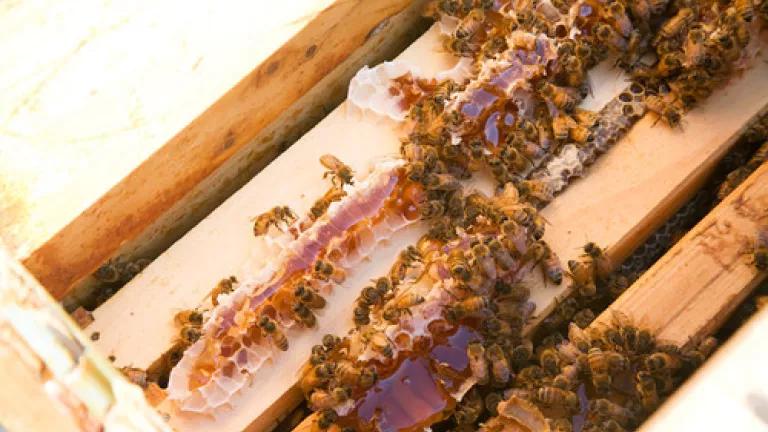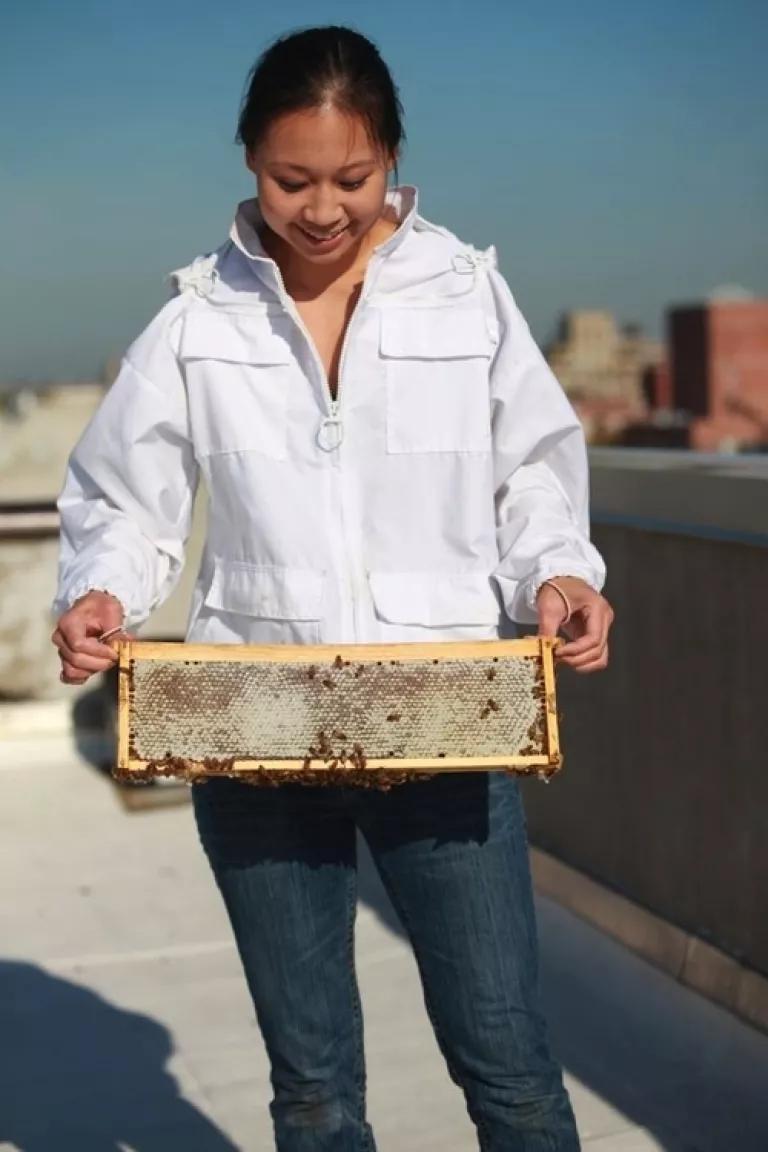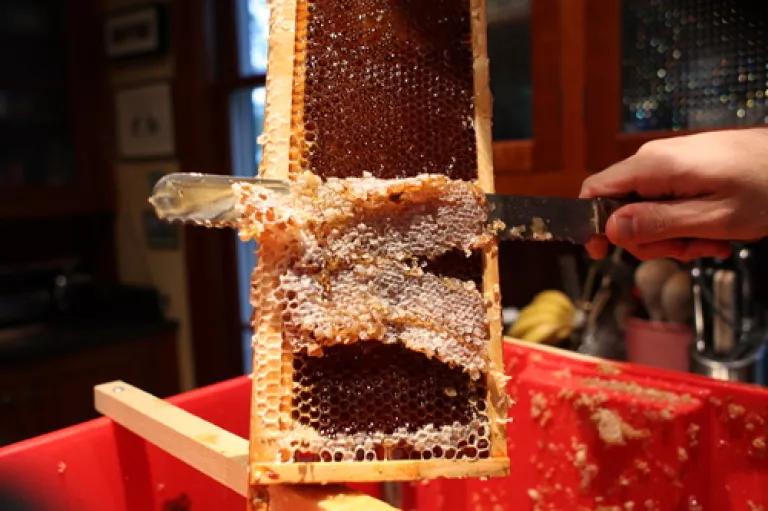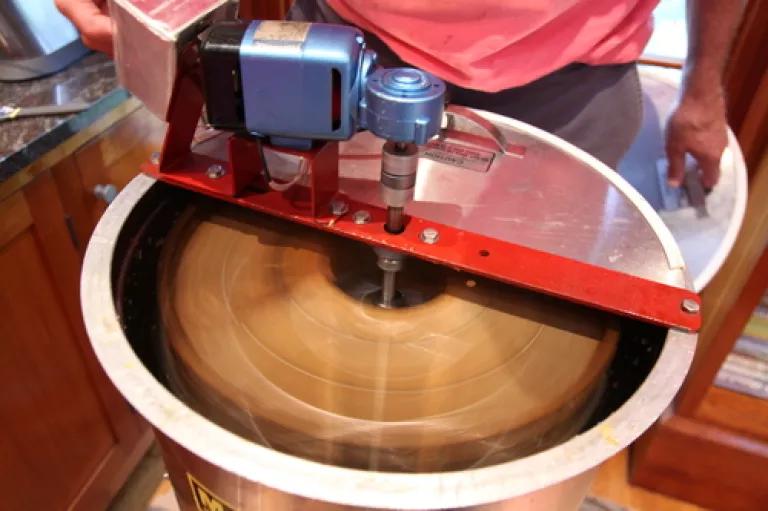
Guest blogger Vivian Wang, Legal Fellow
Cities are often portrayed as the antithesis of nature – an environment of steel instead of open sky, gray instead of green. But as NRDC’s work on smart cities demonstrates, urban centers present unique opportunities to rethink and reshape our environment. As one sweet example of matching action with advocacy, NRDC’s New York office just celebrated its first harvest of rooftop honey.
In my first season as an urban beekeeper, I have come to appreciate an unlikely juxtaposition of city sounds – the roar of subway trains beneath my feet and the hum of honeybees above my head. Four months and seven stings into this adventure, I was delighted to find that our office bees had filled three supers – the shallow boxes in which bees store excess honey – with beautiful amber liquid. It was harvest time.
Credit: Alex Brown
Beekeeper Charles Branch of Let It Bee Apiaries guided me through the honey harvest process, starting from the rooftop. Each super holds ten frames on which the bees build comb and store honey. Charles and I methodically removed each frame, careful not to break open the wax cappings covering each cell of honey. Then we brushed the bees off the frames so that they would return to the hive. When we completed this process, Charles wrapped the frames in plastic bags (spilled honey makes a sticky mess), transported the frames down twelve stories, and whisked them (along with a few straggler bees) up to Westchester, where Let it Bee maintains country bees and stores honey harvesting equipment.

Credit: Matthew Cohen
The following weekend, I took a train forty minutes north of the city to Hastings-on-Hudson, where Charles and Christine (partners in beekeeping and other adventures) graciously hosted a honey extraction jamboree. My colleague Anthony Clark, who has spent significant time in the Gulf responding to the oil disaster, came along to document the final stages of the NRDC honey production.
The extraction process was surprisingly simple. We first scraped off the wax cappings covering the honeycomb. (The honey-soaked wax is like candy – sweet and chewy.)


Credit: Anthony Clark/NRDC
After the frames were spun clean, we opened the spigot at the bottom of the extractor, allowing the honey to flow through a sieve (to catch stray bits of comb) and into a pail. The final step was drawing out a ladle of honey for sampling. NRDC’s rooftop bounty radiated a rich amber tone and, drizzled over slices of bread, had an earthy, floral taste with a slightly spicy finish – a product, perhaps, of our bees’ New York attitude.

Credit: Anthony Clark/NRDC
Before NRDC’s litigation on behalf of bees (we succeeded in overturning registration of a pesticide potentially toxic to honeybees), I knew very little about bees and honey. Under the tutelage of Dr. Chavarria, then-NRDC Science Director and now-Fish & Wildlife Service Science Advisor, and after taking a beekeeping course with the New York City Beekeepers Association, I’ve learned some fun and important facts. One-third of our food benefits from the pollination of honeybees. The California almond crop alone relies on 1.3 million colonies of bees each year for pollination. A bee will fly up to three miles from the hive to collect nectar and makes only one-twelfth of a teaspoon of honey in her lifetime (yes, her – all worker bees are female). And pollinators are in trouble.
Bee populations have experienced a significant decline in recent years, with a reported loss of almost 34% of the country’s managed bee colonies over winter 2009/2010. Studies suggest that pollinator decline (including the phenomenon of colony collapse disorder) is linked to a combination of stressors: pesticides, poor nutrition (bees used for commercial pollination subsist on monofloral diets), pathogens and pests (from diseased bees imported from other countries), habitat loss, and climate change. A recent University of Toronto study, which was conducted over a seventeen-year period in the Rocky Mountains, suggests that there is a “climate-driven mismatch between the times when flowers open and when bees emerge from hibernation.” After a summer that set heat records all across the United States and anecdotal reports from my beekeeper friends of low honey yields in the area, it is becoming increasingly clear that climate change leaves little untouched, including the health of keystone species like bees.
The shortage of bees and concomitant reduction in domestic honey production has fostered criminal honey laundering schemes. A group of German and Chinese executives were indicted earlier this month for conspiring to illegally import Chinese-origin honey, including honey adulterated with antibiotics, into the United States. The honey was labeled as originating in other countries in an effort to avoid $80 million in anti-dumping duties.
While news of honey smuggling generated amusing puns (honey sting, funny honey, a sticky trail of intrigue), there is little to joke about when it comes to the health of our pollinators and the safety of our food system. The decline of bee populations is one of many warning signs that we need to act now to stem the tide of toxic chemicals and curb global warming.
To paraphrase our litigation director Mitch Bernard (who jokingly asks me which client I’m billing for my time on the roof), honeybees – and polar bears, wolves, and countless other species under threat – are defenseless creatures that require people to make real the protections that Congress has provided. Or, as Justice William O. Douglas wrote in his dissenting opinion in a landmark environmental case, just as corporations and ships are given legal “personalities” that enable their participation in litigation, so too, should we permit valleys, groves of trees, and rivers – which all “feel the destructive pressures of modern technology and modern life” – to be plaintiffs in court, speaking “for the ecological unit of life that is a part of it.” I will not opine on whether bees should have legal standing, but our winged friends need protection as a species without which life would be far less sweet.
